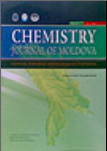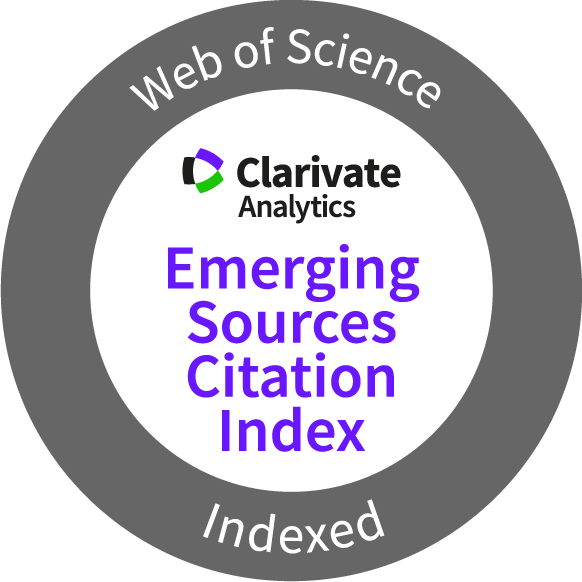Chemistry Journal of Moldova
Inorganic and coordination chemistry
Author(s):
Field: Inorganic and coordination chemistry
Type: Research paper
Issue: 2007 Volume 2, no.1
Pages: 88-92
Krisztina Kovács, Alexander A. Kamnev, Alexei G. Shchelochkov, Ernő Kuzmann, János Mink 3, Tünde Megyes, Attila Vértes
Field: Inorganic and coordination chemistry
Type: Research paper
Issue: 2007 Volume 2, no.1
Pages: 88-92
Full Text (PDF): Download
DOI: dx.doi.org/10.19261/cjm.2007.02(1).09
Graphical Abstract: Interactions of a series of indole-3-alkanoic acids (with n-alkanoic acid side-chains from C1 to C4) with iron(III) in acidic aqueous solutions have been shown to comprise two parallel processes including complexation and redox transformations giving iron(II) hexaaquo complexes. The structure and composition of the reaction products are discussed, as analysed using a combination of instrumental techniques including 57Fe Mössbauer, vibrational and HNMR spectroscopies.
Downloads: 13
Author(s):
Field: Inorganic and coordination chemistry
Type: Research paper
Issue: 2007 Volume 2, no.1
Pages: 83-87
Sergiy Smola, Natalya Rusakova, Elena Martsinko, Inna Seifullina, Yuriy Korovin
Field: Inorganic and coordination chemistry
Type: Research paper
Issue: 2007 Volume 2, no.1
Pages: 83-87
Full Text (PDF): Download
DOI: dx.doi.org/10.19261/cjm.2007.02(1).10
Graphical Abstract: Four new heteronuclear lanthanide complexes with general formula [Ge(OH)(μ-HDTPA)LnGe(OH) (μ-DTPA)] (Ln = Sm – Dy) were synthesized and subsequently characterized by different physico- chemical methods. The structures of new compounds have been proposed. In considered complexes the 4f-luminescence of three-charged ions of samarium, europium, terbium and dysprosium is realized at UV-excitation. It is noteworthy that it is the first observation of 4f-luminescence in water solutions of heteronuclear f-p-complexes. The comparison of luminescent characteristics of hetero- and homonuclear landthanide complexes is described and discussed as well.
Downloads: 18
Author(s):
Field: Inorganic and coordination chemistry
Type: Review
Issue: 2007 Volume 2, no.1
Pages: 17-35
Boris Tsukerblat, Alex Tarantul, Achim Müller
Field: Inorganic and coordination chemistry
Type: Review
Issue: 2007 Volume 2, no.1
Pages: 17-35
Full Text (PDF): Download
DOI: dx.doi.org/10.19261/cjm.2007.02(1).17
Graphical Abstract: In this paper we give a short overview of our efforts in the understanding of the magnetic properties of the fascinating nanoscopic cluster K6[VIV15As6O42(H2O)]·8H2O (hereafter V15) exhibiting layers of magnetization. We analyze EPR and adiabatic magnetization of the V15 cluster with a triangular VIV3 array causing spin frustration. A model for V15 includes isotropic an
Downloads: 40
Author(s):
Field: Inorganic and coordination chemistry
Type: Research paper
Issue: 2006 Volume 1, no.1
Pages: 97-99
Ghenadie Novitchi, Jean-Pierre Costes, Lilia Popovschi, Sergiu Shova, Aurelian Gulea
Field: Inorganic and coordination chemistry
Type: Research paper
Issue: 2006 Volume 1, no.1
Pages: 97-99
Full Text (PDF): Download
DOI: dx.doi.org/10.19261/cjm.2006.01(1).03
Graphical Abstract: The magnetic susceptibility (χT) of an unusual dissymmetric binuclear manganese corboxylate complex has been measured from 2 to 300K. The magnetic data which have been fitted with help of the Heisenberg Dirac Van Vleck HDVV spin-exchange Hamiltonian H = − J S 1 S 2 , indicate that an antiferromagnetic interaction equal to J = -0.90(1) cm-1 is present. A correlation between J values and Mn-H2O-Mn angles has been tempted.
Downloads: 22
Author(s):
Field: Inorganic and coordination chemistry
Type: Research paper
Issue: 2006 Volume 1, no.1
Pages: 88-96
Marco Bettinelli, Adolfo Speghini, Gabriele Bocelli, Olesea Gherco, Valeriu Mereacre, Denis Prodius, Constantin Turta
Field: Inorganic and coordination chemistry
Type: Research paper
Issue: 2006 Volume 1, no.1
Pages: 88-96
Full Text (PDF): Download
DOI: dx.doi.org/10.19261/cjm.2006.01(1).04
Graphical Abstract: Reaction in methanol solution of the trinuclear ‘basic’ chromium(III) acetate with Pr(NO3)3⋅5H2O and further extraction by chloroform-acetone mixture led to the formation of novel unusual [Cr3O(CH3COO)6(H2O)3]NO3⋅HNO3⋅H2O (1) cluster with one “free” molecule of nitric acid. Complex 1 crystallizes in the monoclinic space group P21/c with, at room temperature, a = 13.624(2), b = 15.032(2), c = 15.180(2) Å, β = 112.98(3) °, Z = 4, and V = 2862.09 Å3. The obtained crystalline compound has been synthesized and characterized by IR and UV/Vis methods.
Downloads: 35
Author(s):
Field: Inorganic and coordination chemistry
Type: Research paper
Issue: 2006 Volume 1, no.1
Pages: 84-87
Victor Ciornea, Aurelian Gulea
Field: Inorganic and coordination chemistry
Type: Research paper
Issue: 2006 Volume 1, no.1
Pages: 84-87
Full Text (PDF): Download
DOI: dx.doi.org/10.19261/cjm.2006.01(1).05
Graphical Abstract: Heterometallic complexes of chromium (III) with some 3d metals have been synthesized based on nitrilotriacetic acid (H3nta), like M(bpy)2Cr2(OH)2(nta)2·nH2O, where M = Mn2+, Co2+, Ni2+ and Zn2+; bpy = α,α′- bipyridine; n = 8 or 9. Their chemical composition has been determined from the results of the elemental analysis and thermogravimetric study. The coordination modes of the nta3 ̄ ligand and the type of chemical bonds have been proposed basing on IR spectra.
Downloads: 29
Author(s):
Field: Inorganic and coordination chemistry
Type: Research paper
Issue: 2006 Volume 1, no.1
Pages: 77-83
Denis Prodius, Valeriu Mereacre, Sergiu Shova, Maria Gdaniec, Yurii Simonov, Lorenzo Sorace, Andrea Caneschi, Nicolae Stanica, Ion Geru, Constantin Turta
Field: Inorganic and coordination chemistry
Type: Research paper
Issue: 2006 Volume 1, no.1
Pages: 77-83
Full Text (PDF): Download
DOI: dx.doi.org/10.19261/cjm.2006.01(1).09
Graphical Abstract: The novel bis(μ3-oxo) tetranuclear trichloracetate cluster, [Fe4O2(CCl3COO)8(THF)2(DMF)(H2O)]⋅THF (1), has been synthesised and subsequently characterised by X-ray structure analysis, magnetic measurements and infra red (IR). The structure of cluster is “butterfly” type. The Fe···Fe separation has the value of 2.883(1) - 3.441(7) Å. The coordination number of iron (III) is 6. Magnetic studies reveal the presence of an antiferromagnetic exchange in the parallelogram skeletons of the tetranuclear species. Using the spin Hamiltonian H = -2Jwb(Ŝ1Ŝ2 + Ŝ2Ŝ3 + Ŝ3Ŝ4 + Ŝ4Ŝ1) - 2JbbŜ2Ŝ4v+ gμβ(Ŝ1z + Ŝ2z +Ŝ3z + Ŝ4z)B, the fitting parameters Jbb = - 14.3 cm-1, Jwb = - 32.1 cm-1 , g = 2.07, ρparam. -5 impur. = 4.2 %, ΘCurie-Weiss const. = -0.5 K and R = 6.8·10 were obtained.
Downloads: 21
Author(s):
Field: Inorganic and coordination chemistry
Type: Research paper
Issue: 2006 Volume 1, no.1
Pages: 73-76
A.G. Lazarescu, T.C. Popa
Field: Inorganic and coordination chemistry
Type: Research paper
Issue: 2006 Volume 1, no.1
Pages: 73-76
Full Text (PDF): Download
DOI: dx.doi.org/10.19261/cjm.2006.01(1).11
Graphical Abstract: The complexes of general formula Cu(H2L) (II); [CuLn(L)(NO3)(H2O)n] (where H4L=N,NI-bis[2- hydroxy(3-
nd investigated by different methods (IR spectroscopy, TG analysis and magnetochemistry). The coordination set of complex generators are Cu(N2O2) and Ln(O8-9). The effective magnetic moment values, μeff, at 300 K are: 1.78 (II), 3.22 (III), 6.44 (V) B.M. The temperature dependence (300-2 K) of magnetic susceptibility of [CuNd(L)(NO3)(H2O)6] indicates the antiferromagnetic interaction between metal ions.
Downloads: 30






